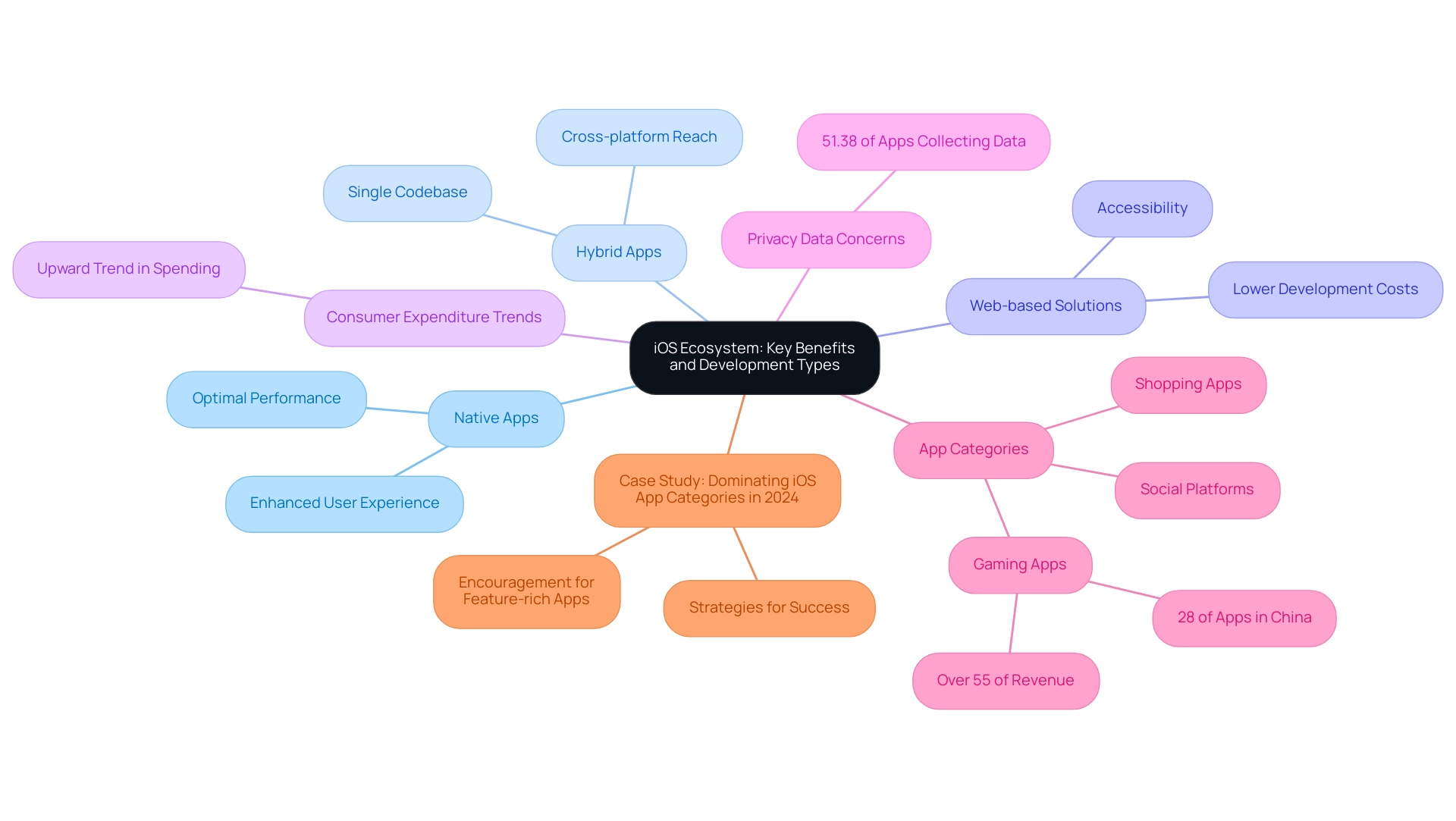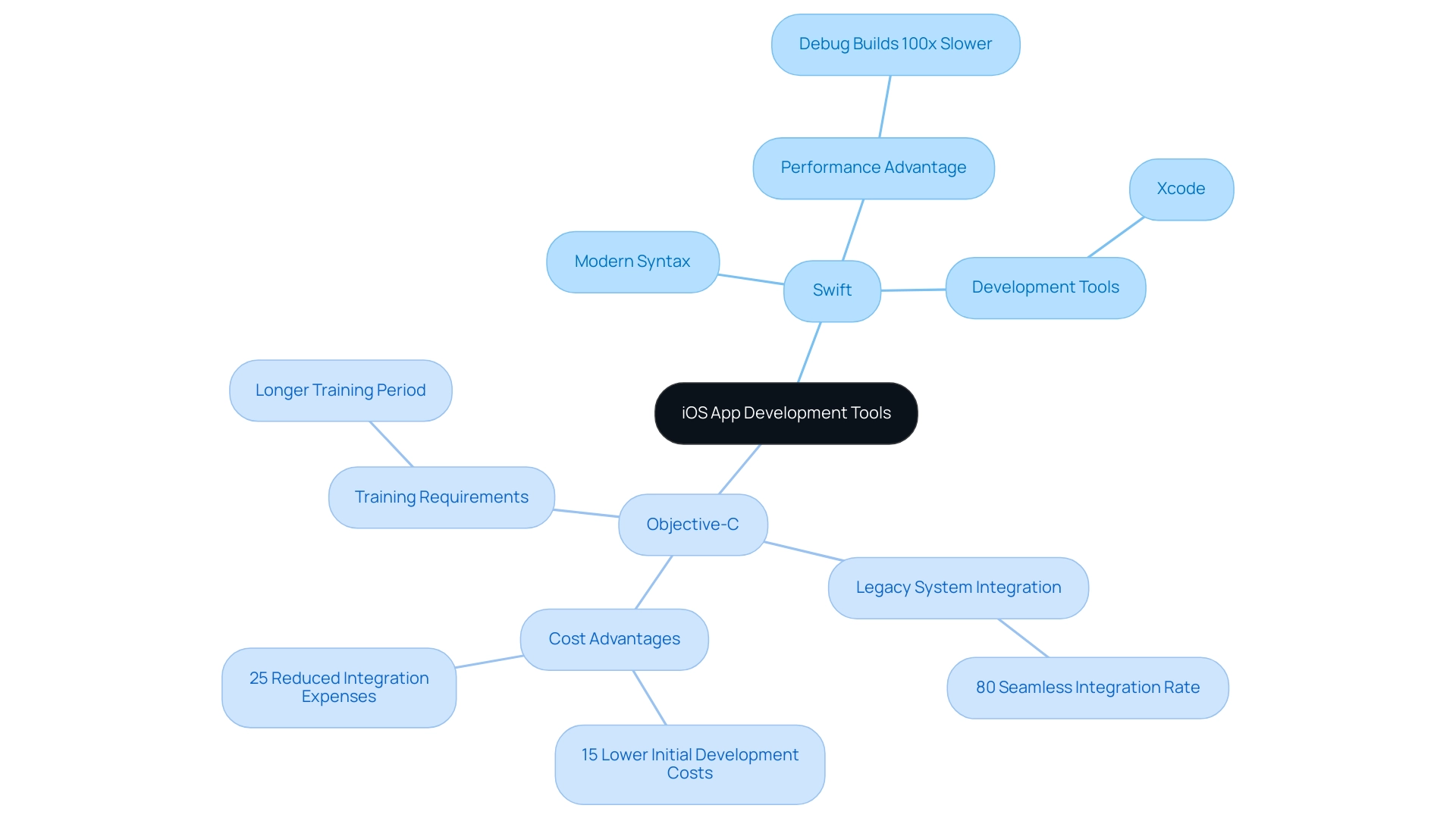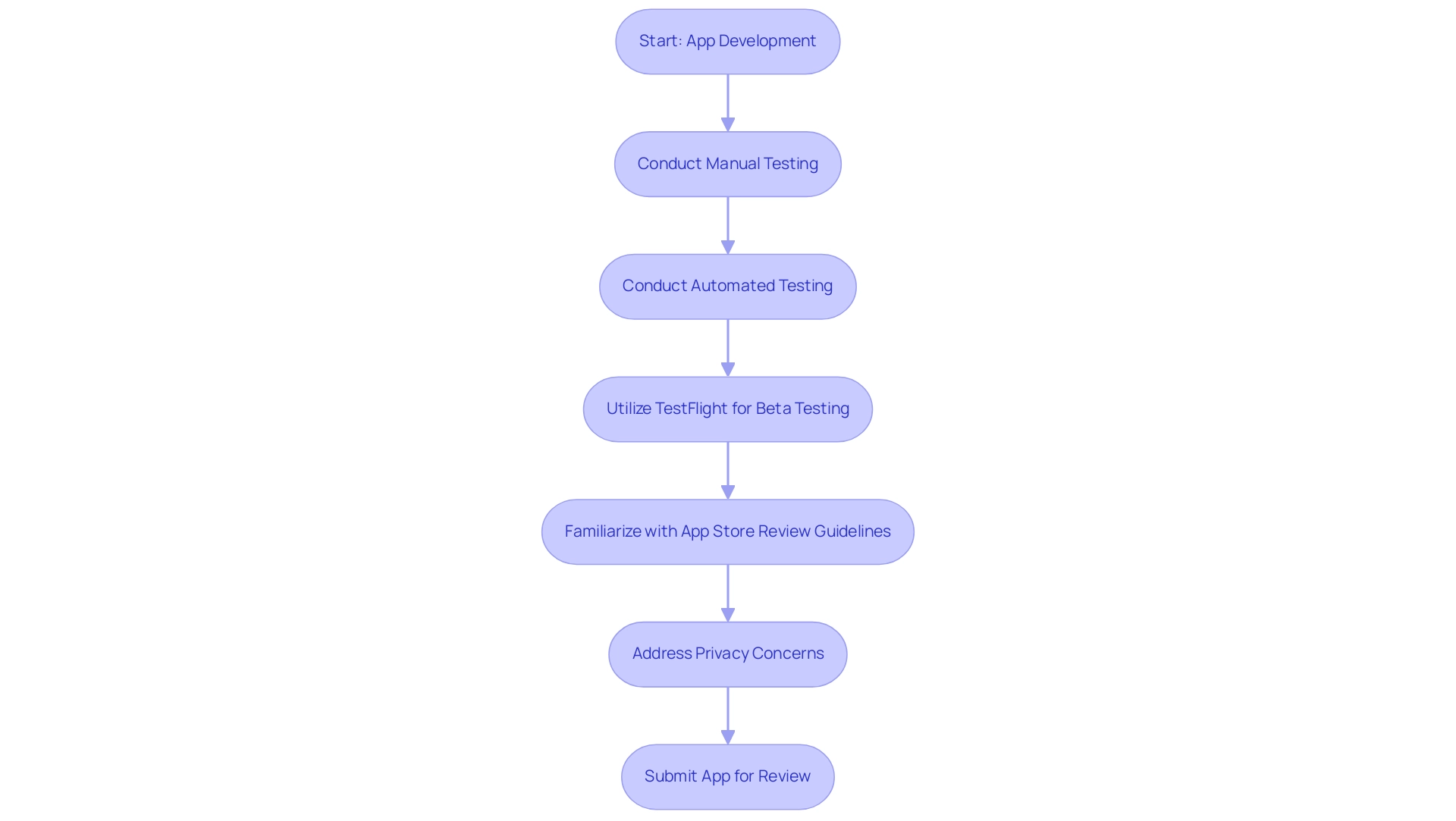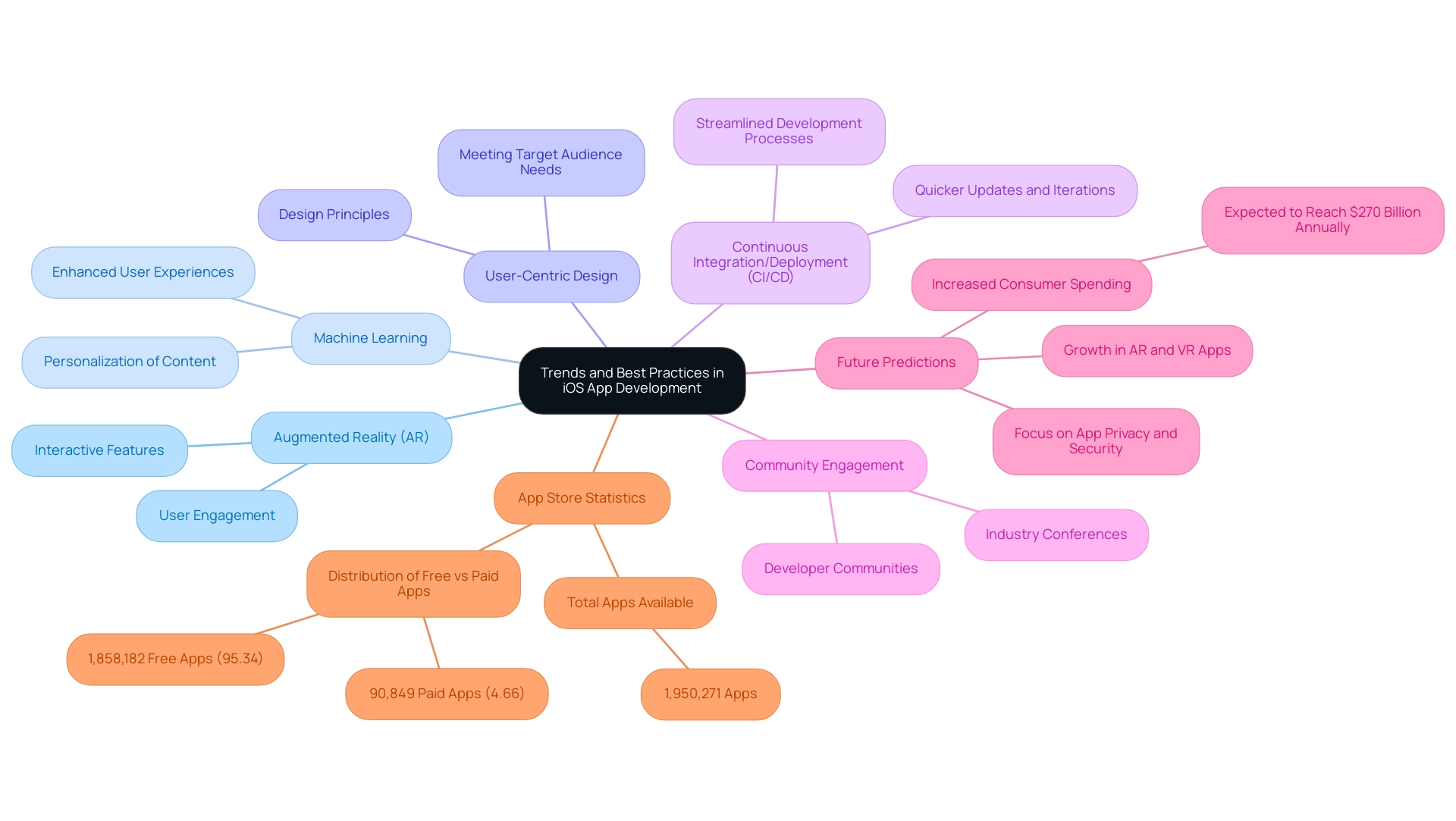Introduction
The iOS ecosystem offers a wealth of opportunities for app developers, driven by a dedicated user base willing to invest in high-quality applications. As the market continues to expand, understanding the nuances of this environment becomes paramount. Developers face critical decisions regarding app types—native, hybrid, or web—and must navigate the complex landscape of user privacy, market trends, and technological advancements.
From defining a clear purpose and conducting thorough market research to selecting the right programming languages and tools, each step in the development process is crucial for success. Moreover, rigorous testing and adherence to App Store guidelines are essential to ensure quality and compliance.
As the industry evolves, staying informed about emerging trends and best practices will empower developers to create engaging and innovative applications that resonate with users and thrive in a competitive market.
Understanding the iOS Ecosystem: Key Benefits and Development Types
The iOS ecosystem offers substantial benefits for app development in iOS, primarily due to its dedicated clientele that tends to invest in high-quality applications. As of 2024, consumer expenditure on iOS applications is anticipated to maintain its upward trend, indicating a robust market for app development in iOS that creators can capitalize on. Significantly, as of September 2024, 51.38% of free mobile iOS applications reported gathering privacy data from individuals, emphasizing the necessity of addressing privacy concerns in application development.
Within this ecosystem, creators can engage in app development in iOS by building various types of applications, including:
- Native
- Hybrid
- Web-based solutions
Native software, specifically designed for app development in iOS, delivers optimal performance and an enhanced user experience, making it particularly appealing to consumers who prioritize functionality. Conversely, hybrid apps enhance app development in iOS by providing cross-platform capabilities, enabling creators to reach a broader audience with a single codebase.
Vipul Sharma, a seasoned business consultant, observes,
The choice between native and hybrid development ultimately hinges on the target audience and specific project goals.
Understanding these distinctions is essential for programmers involved in app development in iOS, as aligning with Apple's guidelines and user expectations is crucial for success. Furthermore, certain app categories, such as gaming, shopping, and social platforms, are thriving due to advancements in app development in iOS.
Gaming apps account for 28% of the apps available in China and alone make up over 55% of the revenue generated from app development in iOS. This data underscores the importance of selecting the right approach for app development in iOS to maximize engagement and capitalize on the growing demand within these lucrative segments. Additionally, the case study titled 'Dominating iOS App Categories in 2024' illustrates successful strategies employed by developers in these thriving categories.

Laying the Groundwork: Defining Purpose and Conducting Market Research
Establishing the app's primary purpose is a fundamental step in the development journey. Developers must ask critical questions:
- What specific problem does the app aim to solve?
- Who constitutes its target audience?
Conducting thorough market research is essential to identify current competitors and uncover gaps within the market landscape, especially in an environment where the OTT app market in the US is oversaturated.
Techniques such as surveys, focus groups, and analytics play a pivotal role in gathering insights into preferences and behaviors. With around 75% of mobile individuals reporting that SMS messages incentivized their purchasing decisions, understanding these preferences can directly influence app design and functionality. Additionally, insights from Dr. Dave Chaffey, a prominent digital strategist, underscore the importance of this research, as he has been recognized as one of the marketing 'gurus' who shaped the future of the industry.
The popularity of Instagram as the most downloaded application in 2023 serves as a benchmark for creators to consider app features and engagement strategies. By thoroughly examining the competitive landscape and potential consumer needs, creators can express a distinctive value proposition that not only connects with their audience but also greatly improves their prospects for ongoing success in a progressively crowded market, where only around 10% of applications sustain interaction and income beyond the initial three-month period. This approach is not merely a best practice; it is a strategic necessity for achieving long-term viability in app development in iOS.

Choosing the Right Tools: Programming Languages and Development Environments
In the realm of app development in iOS, Swift and Objective-C stand out as the primary programming languages. Swift, recognized for its modern syntax and user-friendly nature, is frequently the go-to choice for new projects. As noted by Techvalens, Swift is faster compared to Objective-C; that's what Apple's Swift team claims, and it is certainly true.
This performance advantage is significant, especially considering that debug builds in Swift can be 100 times slower than their release counterparts, a factor that programmers must account for during the development process. Xcode serves as the cornerstone of the development environment, offering vital functionalities such as debugging, interface design, and simulator access.
To enhance efficiency, developers should also consider utilizing libraries like CocoaPods for effective dependency management alongside testing frameworks like XCTest for robust unit testing.
Notably, Objective-C remains essential for enterprises that need to manage legacy systems, boasting an impressive 80% seamless integration rate with established frameworks. Additionally, Objective-C offers 15% lower initial development costs and reduces integration expenses by 25% due to its mature tooling, although it does require a longer training period for teams. This compatibility underscores its value in environments where existing systems must be preserved.
Choosing the right tools is crucial for app development in iOS, making it imperative for development teams to evaluate their options based on specific project requirements and the expertise available within their teams.
For further insights, we encourage readers to explore additional resources such as eBooks and technical guides that delve deeper into iOS development best practices.

Testing and Deployment: Ensuring Quality and Compliance for App Store Submission
Thorough testing is essential in app development in iOS before submitting an app to the App Store, as it plays a pivotal role in ensuring both functionality and customer satisfaction. Implementing a combination of manual and automated testing allows for the identification of bugs and guarantees usability across a diverse array of devices. Utilizing TestFlight for beta testing is particularly advantageous; it enables real users to interact with your app and provide valuable feedback, which can be instrumental in refining the final product.
Furthermore, it is crucial to familiarize yourself with Apple's App Store Review Guidelines, which have seen recent updates in 2024. Following these guidelines not only aids in compliance but also tackles potential issues such as privacy concerns, as demonstrated by the 400,000 applications rejected in 2022 for similar reasons (Statista, accessed on December 29, 2024). Additionally, a recent report by 42matters highlights the frequency of mobile app updates on the Apple App Store, shedding light on the dynamic nature of app submissions as of September 29, 2024.
This is particularly relevant in the context of the Apple App Store's 7% increase in app downloads in 2023, where non-gaming apps accounted for 25.2 billion downloads and gaming apps for 8.4 billion. By prioritizing thorough testing and ensuring adherence to guidelines in app development in iOS, creators can significantly enhance the likelihood of a successful approval process and mitigate the risk of app rejection, ultimately leading to improved satisfaction and engagement among individuals.

Staying Ahead: Trends and Best Practices in iOS App Development
The landscape of app development in iOS is in a constant state of evolution, necessitating that developers stay abreast of emerging trends to maintain a competitive edge. As Steve Jobs famously stated, "25 years later, in 2008, Apple launched the App Store and Jobs’ vision for the future became reality," highlighting the transformative impact of this platform. Current best practices emphasize the integration of augmented reality (AR) in app development in iOS, which is projected to see substantial growth, with predictions indicating a notable rise in AR applications by 2025.
This technology enhances experiences and provides interactive features that can significantly engage individuals. Furthermore, the incorporation of machine learning allows for the personalization of content, tailoring user experiences in ways that were previously unimaginable. Prioritizing user-centric design principles is essential, ensuring that applications meet the needs of their target audience effectively.
Implementing continuous integration and deployment (CI/CD) practices can also streamline development processes and enhance product quality, allowing for quicker updates and iterations. Actively engaging with developer communities and attending industry conferences can further provide invaluable insights into the latest methodologies and technologies, keeping your app relevant and competitive in a rapidly changing market. With a staggering 1,950,271 apps currently available on the Apple App Store, including 1,858,182 free apps and 90,849 paid apps, understanding these trends is crucial for success.
Additionally, predictions for app development in iOS in 2025 suggest increased consumer spending expected to reach $270 billion annually, alongside a growing focus on app privacy and security, making it essential to adapt to these evolving dynamics.

Conclusion
The iOS ecosystem presents a wealth of opportunities for developers, characterized by a loyal user base and a growing market for high-quality applications. Understanding the distinctions between native, hybrid, and web app development is crucial, as each approach offers unique advantages tailored to specific project goals and target audiences. Thorough market research, a clearly defined purpose, and an awareness of user preferences set the foundation for successful app creation, particularly in a competitive environment where engagement can be fleeting.
Selecting the right programming languages and tools is equally essential. Swift and Objective-C serve as primary options, each with its own strengths that cater to different project needs. Utilizing robust development environments like Xcode and employing effective testing strategies, including manual and automated methods, ensure that apps not only meet functional requirements but also adhere to the stringent guidelines set forth by the App Store.
As the landscape of iOS app development continues to evolve, staying informed about emerging trends such as augmented reality and machine learning is vital for maintaining a competitive edge. By prioritizing user-centric design and implementing best practices, developers can create innovative applications that resonate with users and thrive in the dynamic iOS marketplace.
Ultimately, the journey from concept to successful app launch requires careful planning, strategic decision-making, and a commitment to quality. Embracing these principles will empower developers to navigate the complexities of the iOS ecosystem and capitalize on the abundant opportunities that lie ahead.





